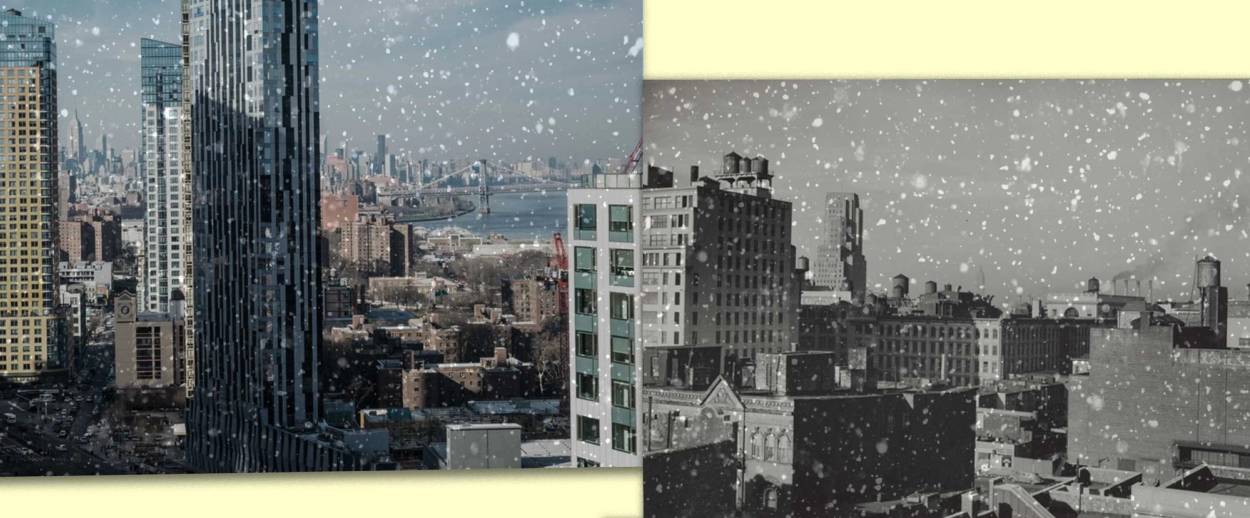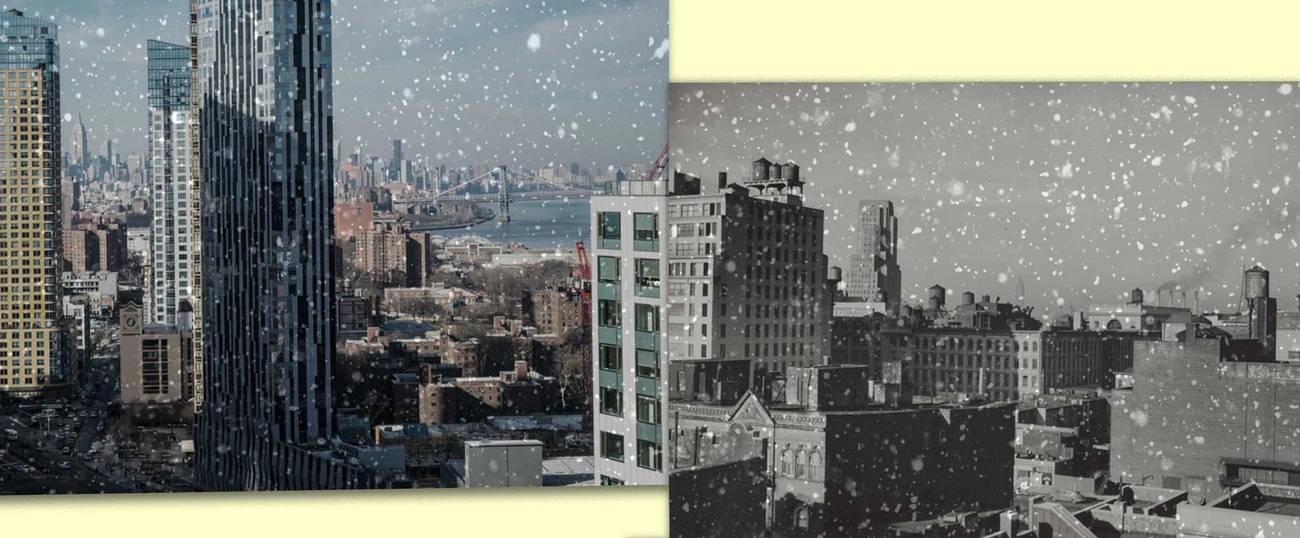Specters of the Skyline
Peering into, and through, the ghostly new Brooklyn




This past Sept. 11, I happened to be on the roof of my home in Brooklyn exactly at sunset, which allowed me to observe the annual commemorative light display at a moment when the display seemed not quite to have begun. The display consisted, as it does every year, of two spectacularly powerful spotlights, beamed upward infinitely from the place in downtown Manhattan where the twin towers used to be. I have seen those twin light beams many times over the years, but always at night, when they are sharply white and ghastly. The spectacle at sunset turned out to be ghastlier. The sky was still bright, and the light beams were invisible, and then barely visible. They looked like the cumulous remnants of a disappeared cloud, or like the faded evaporations of a skywriting plane, or like wisps from an extinguished cigarette, or like something glimpsed out of the corner of an eye, or like a dream that cannot be remembered. The beams were lucent, dimly. But mostly they were translucent. I saw through them to the blue beyond.
To be lucent and translucent at the same time is the sign of a ghost. I take it that ghosts are something that exist, and, then again, do not exist. Ghosts exist, if they do, because we choose to accept them as a paranormal reality, or a supernatural reality, or a conceptual reality. Then again, the natural scientists insist on equating reality with measurement, and, since ghosts do not lend themselves to measurement, the scientists ban them from natural reality. A ghost, therefore, is something that we see, and see through—see because, from various standpoints, the ghost exists; and see through because, from another standpoint, it does not exist. Instead, we see the sky.
Downtown Brooklyn right now has been going through the ghostliest moment in all of its history, which you could have seen during the last few months by waiting for sunset and gazing upward. During all of eternity until now, Brooklyn has sloped upward from the harbor so gradually as to make a nearly horizontal plane. During Indian times the people lived in I do not know what kind of shelters. But the shelters could not have risen very high and, because of the sandy and swampy soil in what we think of as downtown, neither did the trees. Sloping horizontality remained the reality. The Dutch, when they arrived, built their own shelters, which maybe featured an additional floor or an attic, together with an occasional steeple. But Dutch architecture likewise failed to alter the general shape of things.
Only in the 19th century did Brooklyn rise to the mighty height of perhaps three stories, or a towering four stories, as in the case of my own brick dwelling. And thus the reality remained, even if, at the end of the 19th century and the early decades of the 20th, occasional clumps of buildings began to climb still higher—a grand hotel overlooking the harbor, the lonely and ridiculous Williamsburgh Savings Bank Tower, at 37 floors, with its cupola-beanie on top. These were high-rises whose incongruous dimensions seemed only to emphasize the horizontal spirit of everything else. But that was the past. The eternity of the Brooklyn horizontal has just now disappeared in the blink of an eye, a product of the building boom. In the last few months alone, one new structure after another has lifted itself far higher than the preposterous bank tower—new astonishments, pink, silver, gray, blue, facing every which way, like a mountain range, vast, angular, and permanent.
And yet the age of perpendicularity has not entirely arrived. The steel beams penetrate into the sky, attended by cranes and sometimes by temporary exterior elevators. But the facades of the new towers have been only partially attached to those giant beams. Or the rooftops have not been affixed. Or the windows have not been installed. There are steel structures that give way, a hundred floors above the street, to temporary wooden sheds for the construction workers, in conformity to construction techniques of 3,000 years ago. There are towering exteriors without interiors, and interiors without exteriors. Electricity in those spectacular perpendicularities exists only in some areas and not in others, which means that, in the early evening when I gaze upward at the enormous structures, there are moments when I see through the steel beams and the scattered unfinished brickwork and the plywood sheds to the blue sky on the other side, shimmering from the sunset. The new and unfinished buildings appear at that moment to be a mountain range that is somehow also a wisp of smoke, or a dream, or a concept, airy, lucent and translucent at the same time.
Very soon—by next week, possibly—the upper-floor exteriors will finally be affixed, the interiors established, the walls and windows set into place, and the geography of Brooklyn will have changed forever. The imagined will have been created. The porous will be solid. The flat will be upright. Will anyone remember that once upon a time you could see those buildings, and also see through them? In two weeks not even I will remember.
***
You can help support Tablet’s unique brand of Jewish journalism. Click here to donate today.
Paul Berman is Tablet’s critic-at-large. He is the author of A Tale of Two Utopias, Terror and Liberalism, Power and the Idealists, and The Flight of the Intellectuals.